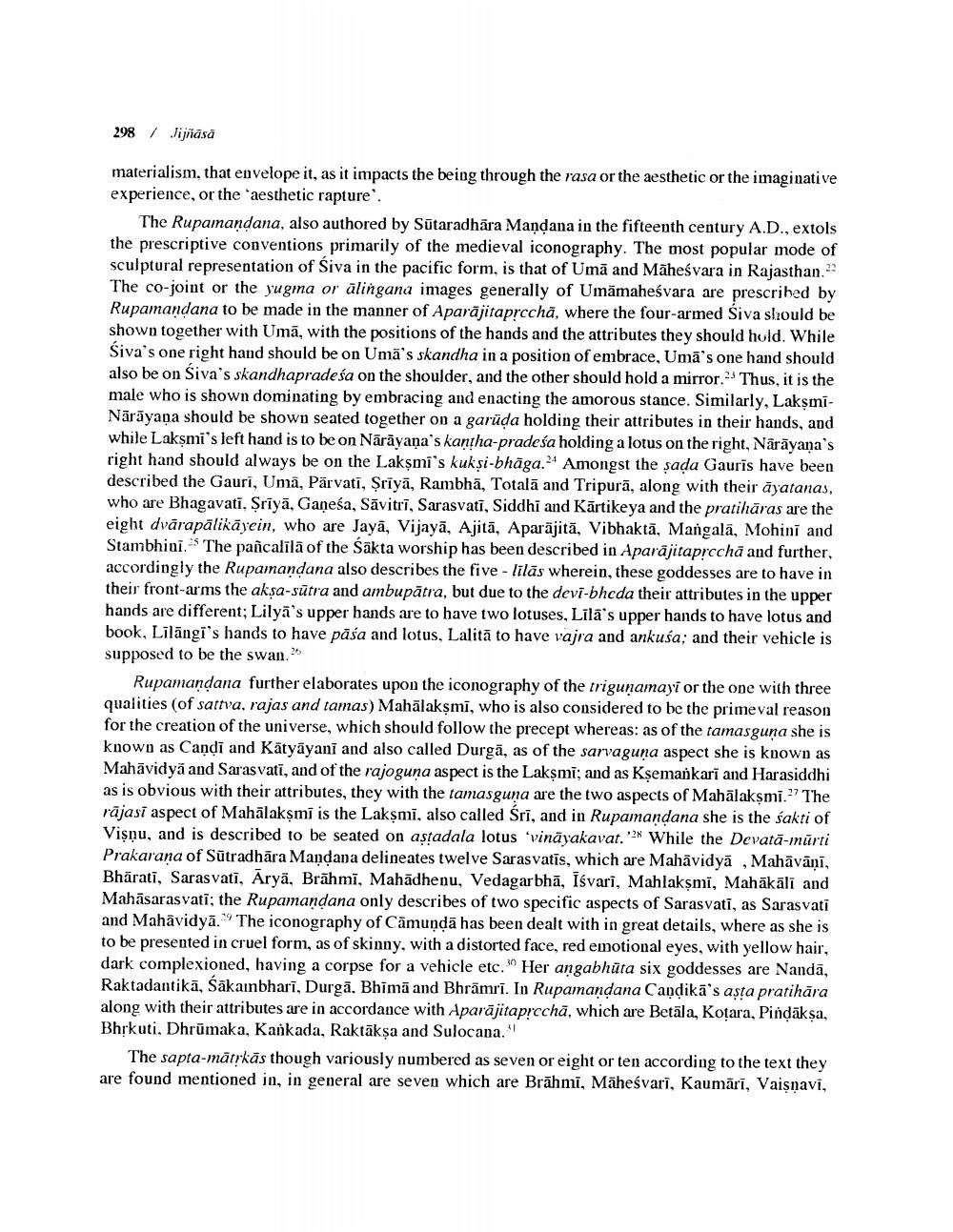________________
298 / Jijñāsā
materialism, that envelope it, as it impacts the being through the rasa or the aesthetic or the imaginative experience, or the 'aesthetic rapture'.
The Rupamandana, also authored by Sutaradhara Maṇḍana in the fifteenth century A.D., extols the prescriptive conventions primarily of the medieval iconography. The most popular mode of sculptural representation of Śiva in the pacific form, is that of Uma and Maheśvara in Rajasthan." The co-joint or the yugma or alingana images generally of Umamaheśvara are prescribed by Rupamandana to be made in the manner of Aparajitaprṛccha, where the four-armed Śiva should be shown together with Uma, with the positions of the hands and the attributes they should hold. While Śiva's one right hand should be on Uma's skandha in a position of embrace, Uma's one hand should also be on Śiva's skandhapradeśa on the shoulder, and the other should hold a mirror.23 Thus, it is the male who is shown dominating by embracing and enacting the amorous stance. Similarly, LakṣmiNārāyaṇa should be shown seated together on a garüḍa holding their attributes in their hands, and while Lakṣmi's left hand is to be on Nārāyaṇa's kantha-pradesa holding a lotus on the right, Nārāyaṇa's right hand should always be on the Lakṣmi's kukşi-bhaga. Amongst the sada Gauris have been described the Gauri, Uma, Pärvati, Ṣriya, Rambha, Totală and Tripura, along with their āyatanas, who are Bhagavati, Ṣriya, Gaṇeśa, Săvitrī, Sarasvati, Siddhi and Kartikeya and the pratihāras are the eight dvarapalikayein, who are Jaya, Vijaya, Ajitä, Aparajitä, Vibhaktä, Mangala, Mohini and Stambhini. The pañcalīla of the Śākta worship has been described in Aparajitaprccha and further, accordingly the Rupamandana also describes the five-līlās wherein, these goddesses are to have in their front-arms the akṣa-sutra and ambupatra, but due to the devi-bheda their attributes in the upper hands are different; Lilya's upper hands are to have two lotuses, Lila's upper hands to have lotus and book, Lilangi's hands to have pasa and lotus, Lalita to have vajra and ankuśa; and their vehicle is supposed to be the swan. 26
Rupamaṇḍana further elaborates upon the iconography of the trigunamayi or the one with three qualities (of sattva, rajas and tamas) Mahalakṣmi, who is also considered to be the primeval reason for the creation of the universe, which should follow the precept whereas: as of the tamasguna she is known as Candi and Katyayani and also called Durga, as of the sarvaguna aspect she is known as Mahavidya and Sarasvati, and of the rajoguna aspect is the Lakṣmi; and as Kṣemankari and Harasiddhi as is obvious with their attributes, they with the tamasguna are the two aspects of Mahalakṣmi." The rājasi aspect of Mahalakṣmi is the Lakṣmi, also called Śrī, and in Rupamanḍana she is the śakti of Vişņu, and is described to be seated on aṣṭadala lotus vinayakavat. '28 While the Devată-murti Prakarana of Sutradhara Maṇḍana delineates twelve Sarasvatis, which are Mahavidyā, Mahāvāṇī, Bharati, Sarasvati, Arya, Brahmi, Mahādhenu, Vedagarbha, Iśvari, Mahlakṣmi, Mahākālī and Mahasarasvati; the Rupamandana only describes of two specific aspects of Sarasvati, as Sarasvati and Mahavidya. The iconography of Camunda has been dealt with in great details, where as she is to be presented in cruel form, as of skinny, with a distorted face, red emotional eyes, with yellow hair, dark complexioned, having a corpse for a vehicle etc.30 Her angabhuta six goddesses are Nandā, Raktadantikā, Śākambhari, Durgā. Bhima and Bhramri. In Rupamandana Candika's aṣṭa pratihāra along with their attributes are in accordance with Aparajitapṛccha, which are Betāla, Kotara, Pinḍākṣa, Bhrkuti, Dhrūmaka, Kankada, Raktākṣa and Sulocana."
The sapta-matṛkās though variously numbered as seven or eight or ten according to the text they are found mentioned in, in general are seven which are Brahmi, Mäheśvari, Kaumārī, Vaiṣṇavī,




